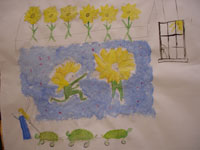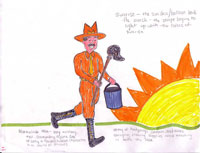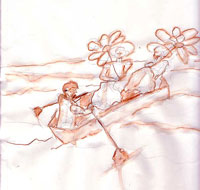I’ve begun reading A Perfect Mess: the hidden benefits of disorder, which proposes that the costs of keeping things organized are not only not worth it, but are illusory. Quite the reverse, they say: mess is not only rational and natural, but also quite beneficial.
What does this have to do with creativity, here on the halfway mark to my 365 days?
Lots, as it turns out. It does not take a lot of thought to figure out how messy people are more creative. It would seem to go with the territory. I think most people would put it the other way, creative people are messy, but that’s not exactly the correlation.
It turns out that mess (and we are talking the usual messy desk, the cluttered study, the bedroom with piles of clothes) has, systemically, six characteristics which, although the authors don’t put it this way (at least not yet in the book), I am connecting to absolute creativity.
Flexibility: Systems that are completely organized are inflexible. They cannot change quickly to meet changes in the environment. I think of media specialists with perfect media centers who freak if a class shows up unscheduled. Systems with a moderate amount of mess have slack and can bend themselves into new shapes without breaking.
Completeness: When you never throw anything away, you’ve always got what you need. Look at the Eames design studio, or Nancy Willard’s drawers of flotsam. Look at my ability to pull up files or lesson plans or whip up a board game complete with projected questions for an entire class in sixty minutes. Also, if you have all this stuff at your disposal, you are more likely to make those interesting connections that flow from truly creative people.
Resonance: Messy systems are open to and can align themselves with outside influences/environments, so that unexpected effects result. The book refers to Alexander Fleming’s messy lab that allowed the intrusion of the penicillin mold into a staph culture while he was on vacation, or to wandering around a city on foot rather than sticking to the tourist attractions.
Invention: Here’s the core, at least for us working on William Blake’s Inn. Mess allows different ideas to rotate in and out of focus; neatness keeps everything boxed in and sweeps away ideas that don’t fit. Like our brainstorming of our three pieces (see completeness), we don’t reject any ideas, even sunflower gowns that spurt turtles. Sooner or later we may need that idea.
Efficiency: This one’s counterintuitive, isn’t it? But think of it like this: a person who puts everything away (e.g., “one-touch” desks) is always having to look for things (and then put them away again.) A person who keeps piles on his desk has the most recent and most useful things at his fingertips. The book gives an amazing example: an efficiency consultant gave two decks of cards to two people in the audience, one shuffled and one in order, and challenged them to pull four specified cards from the deck. Of course the person with the ordered deck found the cards faster, albeit only slightly. However, the authors did some math on the situation and found that the time it takes to put a deck of cards in order and to keep it in order far outweighed the four or five second advantage you get with an ordered deck. Plus, they slyly remind us, how useful is an ordered deck of cards?
Robustness: Messy systems are simply stronger. They are “more resistant to destruction, failure, and imitation.” I am reminded of a couple of times when one person or another sought to “improve” the car rider system at Newnan Crossing by introducing a more rigorous system of matching kids to cars. I pointed out that such rigor simply introduced more breaking points: if any part of the system failed, the whole system failed.
As I keep reading the book, which of course is total self-justification for my personal style, I’ll keep us posted on how important it is not to clear off that desk.




